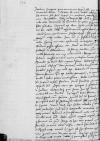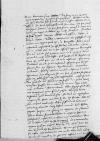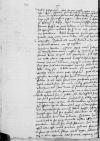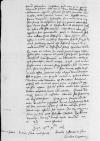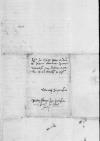Nihil iucundius mihi afferre orig. adferre⌈afferreafferre orig. adferre⌉ potuit ornatissimus iuvenis ⌊Eustachius a Knobelsdorff⌋, quam ⌊⌋ tuas, quae ex ⌊Heylsberg⌋ de data 1540-09-10⌊decimae S written over D⌈DSS written over D⌉eptembris superioris anni1540-09-10⌋ missae eidemque traditae fuerunt. Significabant enim te optima adhuc esse valetudine solitoque paterno erga me animo – id quod gratissimum mihi fuit intelligere. Verum quod ad silentium meum et ingratitudinem, quam accusas, attinet, omnia tibi do, nihil peccare potes,
cf. Cic. Catil. 2.3.4-5 non est ista mea culpa, Quirites, sed temporum ⌊sed mea certe haec non est, sed temporum culpacf. Cic. Catil. 2.3.4-5 non est ista mea culpa, Quirites, sed temporum ⌋.
Scripsi ad te ex ⌊Vienna⌋ longas ⌊⌋, quas illustri domino ⌊Wolphango Brantner⌋ magno magistro ⌊ordinis divi Georgii⌋ in ⌊Austria⌋ in manus consignavi dandas ⌊factori⌋ dominorum ⌊Fuggarorum⌋ in ⌊Cracovia⌋. Atqui ⌊princeps⌋ ille, dum legatus ad serenissimos ⌊reges vestros⌋ proficiscitur, quo primum die ⌊Vienna⌋ excessit, crus fregit ideoque rediit, ⌊⌋ I written over E⌈EII written over E⌉taque tertio sunt eaedem orig. eedem⌈eaedemeaedem orig. eedem⌉ ⌊⌋ ad te remissae, nescio vero, an vel sic pervenerint,[3] quod imprimis tamen opto, erant enim, praeterquam quod ex animo profectae, copiosae et uberes. Quare gratum facies, si me uno atque altero verbo hac dubitatione levaris.[4]
Scribis in ⌊⌋ istis te nullas meas accepisse, de quo non miror. An nesciebas autem me Aprili mense profectum fuisse in ⌊Transylvaniam⌋? Ita enim puto ad te perscriptum fuisse. Sed haec missa sint. De morte tua nullus fuit rumor hic, iampridem postquam antiquum illum discussi, sed ab eo tempore omnes fere, qui hic tibi fuere amicissimi, amisisti, ⌊Marcum imprimis Laurinum⌋ decanum Brugensem, qui mense Novembri, dominum ⌊Adolphum a Burgundia⌋ dominum de Beveris, qui Decembri, multosque alios, ut ⌊capitaneum⌋ ⌊Thamysae⌋,
 UUB, H. 155, f. 37v
⌊Iacobum Snagart⌋,[5] quos enumerare longum esset, qui diversis hidden by binding⌈[s]s hidden by binding⌉ temporibus obiere.
UUB, H. 155, f. 37v
⌊Iacobum Snagart⌋,[5] quos enumerare longum esset, qui diversis hidden by binding⌈[s]s hidden by binding⌉ temporibus obiere.
Ut vero de meis rebus aliquid audias hidden by binding⌈[as]as hidden by binding⌉: ex ⌊Vienna⌋ sub finem Augusti sum profectus venique ad ⌊caesarem⌋ ⌊Bruxellam⌋, neque multo post ill(ustris) or ill(ustrissimus)⌈ill(ustris)ill(ustris) or ill(ustrissimus)⌉
⌊dominus a Granvella⌋ inde abiit ⌊Wormaciam⌋ ad ⌊conventum imperii⌋[6] super negotio orig. negocio⌈negotionegotio orig. negocio⌉ fidei indictum. Secutus orig. Sequutus⌈SecutusSecutus orig. Sequutus⌉ est ⌊illum⌋ ⌊caesar⌋ mense Decembri me hic apud serenissimam ⌊reginam Mariam⌋ ipsius sororem, gubernatricem ⌊harum provinciarum⌋ subsistere iusso, id quod pro hidden by binding⌈[o]o hidden by binding⌉ gratissimo mihi accidit, iam enim in fastidium mihi venit hidden by binding⌈[nit]nit hidden by binding⌉ aula cogitoque me intra testam meam contrahere. Idque ut hidden by binding⌈[t]t hidden by binding⌉ commodius possim efficere, emi domum et dominium inter ⌊Gandavum⌋ et ⌊Aldenardum⌋, ad flumen ⌊Scaldim⌋, pretio orig. precio⌈pretiopretio orig. precio⌉ triginta hidden by binding⌈[a]a hidden by binding⌉ milium written over e⌈eiumium written over e⌉ florenorum aut non multo minus, ⌊Brugae⌋ enim mihi sordent amissis omnibus amicis, quibuscum vivere solebam. Proinde in domum illam migrare statui. Habeo vicum frequentibus aedificiis orig. edificiis⌈aedificiisaedificiis orig. edificiis⌉, bona societate, multis transeuntibus cotidie orig. quottidie⌈cotidiecotidie orig. quottidie⌉ insignem, qui meus est. Habeo domum circumsaeptam orig. circumseptam⌈circumsaeptamcircumsaeptam orig. circumseptam⌉ gemino flumine, hoc est ⌊Scalde⌋ principali et secundario hidden by binding⌈[io]io hidden by binding⌉ Scaldi.[7] Habeo prata amoenissima, habeo merum mistumque ⌊ibi⌋ imperium et ius,[8] secundum ⌊comitem ⌊Flandriae⌋⌋, qui meus est feudi dominus. Distat vicus iste, ⌊Eecque⌋ id est Quercus nomine,[9] a ⌊Gandavo⌋ ⌊Aldenardo⌋que pari spatio orig. spacio⌈spatiospatio orig. spacio⌉, hoc est duobus miliaribus cum dimidio. Ex opposito trans flumen est arx insignis nomine ⌊Gavera⌋, quondam domini de Fiennes, nunc principatus titulum habet[10] spectatque ad ⌊relictam⌋ ill(ustris) or ill(ustrissimi)⌈ill(ustris)ill(ustris) or ill(ustrissimi)⌉
quondam ⌊comitis de Egmond⌋. Vicinum eadem ripa habeo ⌊abbatem⌋ Sancti Petri Gandavensis, cuius vicus ⌊Swynarde⌋[11] continuus est meae ⌊Quercui⌋. Habemus et iurisdictiones inter nos in aliis nonnullis vicis communes. Habeo piscium magnam copiam, praetereaque frumenti omnis generis, itaque ex hac una ⌊Quercu⌋ meam familiam et amicos alere possim ceteris proventibus meis hidden by binding⌈[s]s hidden by binding⌉ et ⌊coniugis meae⌋ intactis, id quod tibi significatum esse volui, quo una mecum Deo gratias ageres. Atque haec ipsi certe Deo et ⌊coniugi⌋ meaemagis debeo, quam principibus, quamquam et illi
 UUB, H. 155, f. 38r
de me benemeriti sunt debeo. Tuae itaque erunt partes amico congratulari, qui senio suo prospexit. Habeo in ⌊eo⌋ domum satis commodam, sed quam cum tempore possum efficere commodissimam. In hanc bibliothecam orig. bybliothecam⌈bibliothecambibliothecam orig. bybliothecam⌉ meam immittere, in hac aetatem transigere decrevi, si qua fata sinant, procul a curis et a curia, cum ⌊uxore⌋ et ⌊liberis⌋, qui mihi duo sunt. Commoditas est flumen ingens, navigio advehi omnia possunt. Distat a ⌊Brugis⌋ septem, totidem a ⌊Watervliet⌋, ubi possessionum nostrarum non exigua pars est,[12] a ⌊Bruxellis⌋ decem tantum miliaribus nostratibus, in ipso ⌊Flandriae⌋ meditullio. Certe cum orig. quum⌈cumcum orig. quum⌉ in multis aliis, tum in hoc effulsit erga me divina gratia, fuit enim venale supra quattuor annis et a magnis ambitum proceribus, mihi autem cessit.
UUB, H. 155, f. 38r
de me benemeriti sunt debeo. Tuae itaque erunt partes amico congratulari, qui senio suo prospexit. Habeo in ⌊eo⌋ domum satis commodam, sed quam cum tempore possum efficere commodissimam. In hanc bibliothecam orig. bybliothecam⌈bibliothecambibliothecam orig. bybliothecam⌉ meam immittere, in hac aetatem transigere decrevi, si qua fata sinant, procul a curis et a curia, cum ⌊uxore⌋ et ⌊liberis⌋, qui mihi duo sunt. Commoditas est flumen ingens, navigio advehi omnia possunt. Distat a ⌊Brugis⌋ septem, totidem a ⌊Watervliet⌋, ubi possessionum nostrarum non exigua pars est,[12] a ⌊Bruxellis⌋ decem tantum miliaribus nostratibus, in ipso ⌊Flandriae⌋ meditullio. Certe cum orig. quum⌈cumcum orig. quum⌉ in multis aliis, tum in hoc effulsit erga me divina gratia, fuit enim venale supra quattuor annis et a magnis ambitum proceribus, mihi autem cessit.
Sed hactenus ibi degere non licuit, quod nondum potui me ab aula absolvere, paro tamen commoditates abeundi, quas eo facilius assequar, quo longe plurimi sunt, qui ingenia excellentiora, maiorem eruditionem gratiamque rebus in omnibus, afferunt orig. adferunt⌈afferuntafferunt orig. adferunt⌉ in medium aestimatione orig. estimatione⌈aestimationeaestimatione orig. estimatione⌉, quae aliquanta de me fuit, cotidie orig. quottidie⌈cotidiecotidie orig. quottidie⌉ senescente, quod neque praeter orig. preter⌈praeterpraeter orig. preter⌉ spem, neque praeter exspectationem mihi usuvenit. Tam incommode enim versatusne ms. versatus ne(!)
⌈versatusneversatusne ms. versatus ne(!)
⌉ ego fuissem in studiis litterarum, versatus fuissem tot in actionibus, ut nova haec videri mihi deberent?
⌊Panormitanus⌋ adhuc superest, sed abdicato magistratu, quem summum gessit,[13] domi suae vivit exspectans horam vocationis suae. Ad ⌊illius⌋ me exemplum compono, sed aetate non tam, quam ille est, fracta, Deo enim gratia corporis vires mihi adhuc sufficiunt ad labores periculaque toleranda neque defecit animus, sed t written over ...⌈... illegible⌈...... illegible⌉tt written over ...⌉aedet perpetuo frustra niti, statuique me exercere in sacrarum litterarum lectione, si quando dabitur a negotiis orig. negociis⌈negotiisnegotiis orig. negociis⌉ feriari orig. faeriari⌈feriariferiari orig. faeriari⌉.
⌊Godtscalcus⌋ noster diu conflixit cum valetudine, nunc autem a ⌊caesare⌋ missus est in written over ad⌈ad in in written over ad⌉ ⌊Hungariam⌋ ad procuranda negotia orig. negocia⌈negotianegotia orig. negocia⌉ quaedam serenissimae ⌊reginae Mariae superinscribed⌈MariaeMariae superinscribed⌉⌋, ubi aestatem hanc, uti reor, ad minus est transacturus.
De me quid futurum sit, nescio, sed condicionem orig. conditionem⌈condicionemcondicionem orig. conditionem⌉ non ambio ullam aliam, nisi ex commodo esset reipublicae. Cui privatos affectus meos haud
 UUB, H. 155, f. 38v
dubie postponerem, sed in quo posset opera mea esse usui, cum orig. quum⌈cumcum orig. quum⌉ praesertim summa rerum, de qua agitur, summis et extremis sit viribus defendenda, in quas, rogo, quid ego conferre possem? Satis habeo compertum, si ⌊Hieronymo a Lasky⌋ legatio Turcica successisset prospere, futurum fuisse, ut pars laborum in me derivaretur, sed exemplum crudelius est, quam ut in eodem plures debeant orig. daebeant⌈debeantdebeant orig. daebeant⌉ periclitari. Rebus Hungaricis, quoad potui, modeste hidden by binding⌈[e]e hidden by binding⌉ intendi neque reor nomen ullum me, nisi bonum, illic reliquisse. Crebrius orig. Craebrius⌈CrebriusCrebrius orig. Craebrius⌉ autem eandem orig. eamdem⌈eandemeandem orig. eamdem⌉ fortunam in hac acerbitate animorum tentare non est consultum.
UUB, H. 155, f. 38v
dubie postponerem, sed in quo posset opera mea esse usui, cum orig. quum⌈cumcum orig. quum⌉ praesertim summa rerum, de qua agitur, summis et extremis sit viribus defendenda, in quas, rogo, quid ego conferre possem? Satis habeo compertum, si ⌊Hieronymo a Lasky⌋ legatio Turcica successisset prospere, futurum fuisse, ut pars laborum in me derivaretur, sed exemplum crudelius est, quam ut in eodem plures debeant orig. daebeant⌈debeantdebeant orig. daebeant⌉ periclitari. Rebus Hungaricis, quoad potui, modeste hidden by binding⌈[e]e hidden by binding⌉ intendi neque reor nomen ullum me, nisi bonum, illic reliquisse. Crebrius orig. Craebrius⌈CrebriusCrebrius orig. Craebrius⌉ autem eandem orig. eamdem⌈eandemeandem orig. eamdem⌉ fortunam in hac acerbitate animorum tentare non est consultum.
Epigramma Venetum videram ⌊Agriae⌋ mense Iulio, cum orig. quum⌈cumcum orig. quum⌉ ex ⌊Transsylvania⌋ venirem, missum ex ⌊Cracovia⌋ per dominum ⌊Severinum Boner⌋ ad reverendissimum ⌊dominum Agriensem⌋, sed responsio tua valde placuit nostratibus et serenissimae cumprimis ⌊reginae Mariae⌋, cuius maiestati ⌊⌋ tuas atque ipsum carmen ostendi.
Quae inter duos orbis ⌊monarchas⌋ aguntur, duobus dicam verbis. Uterque sua. A bello vacant, sed non cessant practicae, utinam ab omni parte Christianae.[14] Potes autem tibi habere hidden by binding⌈[abere]abere hidden by binding⌉ persuasum universa ex fine huius ⌊conventus Germanici⌋[15] dependere. Si enim ⌊caesar⌋ ⌊Germaniam⌋ pacificare poterit, nulli hidden by binding⌈[i]i hidden by binding⌉ hostes metuendi sunt, sin minus, undique periculum illi nobisque video imminere. Iam ⌊Turca⌋ prae foribus est, acer admonitor salutis nostrae aut nunc procurandae, aut in aeternum orig. eternum⌈aeternumaeternum orig. eternum⌉ amittendae. Nulli exercitus sunt in ⌊Galliis⌋, sed illic dissidium fuit ingens hidden by binding⌈[s]s hidden by binding⌉ inter duos primarios viros, ⌊conestabilem⌋ scilicet eundemque magnum magistrum regni ex una, et ⌊admiraldum⌋ ex alia parte. Quo effectum est, ut ⌊admiraldus⌋ post multas informatio hidden by binding⌈[io]io hidden by binding⌉nes deprehensus sit contra, quam debuit, egisse ideoque sententia adversus ipsum lata fuit ingens, damnabatur enim ad perpetuos carceres bonis omnibus publicatis, spoliabatur honoribus omnibus, sed et spe quoque aliquando eosdem assequendi privabatur. Lata autem fuit mense Februario. Iam de rebus ⌊ipsius⌋ actum esse omnes putabant, cum orig. quum⌈cumcum orig. quum⌉ ecce femineis orig. foemineis⌈femineisfemineis orig. foemineis⌉, ut fama est, artibus flexa mente ⌊regis⌋[16] sublata est atque in totum expuncta eadem sententia, restitutique ⌊damnato⌋
 UUB, H. 155, f. 39r
sui honores atque fortunae non sine summa omnium admiratione, quibus legum maiestas sanctior esse debere videbatur, quam ut tam exiguo tempore
cf. Vulg. Apc 3.16.1-2 sed quia tepidus es et nec frigidus nec calidus incipiam te evomere ex ore meo ⌊calidum frigidumque uno ore effunderentcf. Vulg. Apc 3.16.1-2 sed quia tepidus es et nec frigidus nec calidus incipiam te evomere ex ore meo ⌋.[17]
UUB, H. 155, f. 39r
sui honores atque fortunae non sine summa omnium admiratione, quibus legum maiestas sanctior esse debere videbatur, quam ut tam exiguo tempore
cf. Vulg. Apc 3.16.1-2 sed quia tepidus es et nec frigidus nec calidus incipiam te evomere ex ore meo ⌊calidum frigidumque uno ore effunderentcf. Vulg. Apc 3.16.1-2 sed quia tepidus es et nec frigidus nec calidus incipiam te evomere ex ore meo ⌋.[17]
In ⌊Anglia⌋ itidem pax est, nisi quod contra ⌊Scotos⌋ arces oppidaque muniuntur, prout et adversus alios actum esse ferunt, sed ⌊Anglis⌋ videtur belli causa contra ⌊Francos⌋ esse, quod ab aliquot mensibus Franci in ditionem Anglorum non procul a ⌊Calysio⌋ moliri nonnihil visi sunt. Qua de re levia aliquot certamina advenere. Est et ⌊Anglis⌋ periculosa ⌊Ardea⌋ urbecula illis finitima, quam ⌊Franci⌋ magno molimine sunt munire orsi propeque munitionem illam ad finem usque perduxere. Econtra iisdem ⌊Anglis⌋ contra ⌊Scotos⌋ belli causa esse potest, quod Scoti plerosque monachos et nobiles Anglos, qui crudelitatem, quae in ⌊Anglia⌋ exercita fuit, effugere potuerunt, hospitaliter susceperunt neque dedere eosdem volunt petenti ex foedere ⌊regi Anglorum⌋ ad supplicium asserentes se ad huiusmodi iniqua nullis foederibus teneri, quippe cum orig. quum⌈cumcum orig. quum⌉ tale aliquid ne cogitatum quidem fuerit, quo tempore foedera inibantur, parvique videntur facere minas ⌊Anglorum⌋. Haec ita esse omnino aestimare orig. estimare⌈aestimareaestimare orig. estimare⌉ debes. Sed contra ⌊Belgicam⌋ nostram non arbitror ⌊Anglos⌋ aliquid ausuros, neque enim causam habent ullam, quamquam circa usum mercimoniorum et modos navigandi nonnulla per illos sunt innovata adversum nostros, quae ipsorum exemplo edocti vicissim in written over l⌈lnn written over l⌉ illos retorsimus.
Idem ⌊rex Anglorum⌋ alit in suo ⌊regno⌋ ⌊sororem⌋ ⌊ducis Cliviae et Iuliaci⌋, quam pro uxore legitima semel ductam conscientia motus, quod ⌊alteri⌋ prius fidem dedisset, a se dimisit[18] et cum ⌊altera⌋ cohabitat Clivensi interim liberaliter vivente. Qua de re aliis ⌊⌋ meis ad te scripseram. Cum ⌊regno Danorum⌋ neque pax nobis est, neque bellum, sed ex eo regno oratores venire debent ⌊Ratisbonam⌋ ad ⌊caesarem⌋, quibuscum de iis, quae negotium orig. negocium⌈negotiumnegotium orig. negocium⌉ illud concernunt, agetur. ⌊Ducatus Gheldriae⌋ ⌊ducem Iuliaci⌋ assumptum dimittere non velle videtur. Missus ⌊eo⌋ fuerat a ⌊caesare⌋
 UUB, H. 155, f. 39v
⌊Levinus noster Panagathus⌋, qui de numero est heraldorum caesaris, ut diem indiceret ⌊illis⌋ et ⌊duci⌋, quo die praesto essent ad audiendum, quae sibi obicere[n]tur orig. obiicere[n]tur⌈obiceren hidden by binding⌈[n]n hidden by binding⌉turobicere[n]tur orig. obiicere[n]tur⌉, sed dux ipse nondum abiit ad illum diem, fertur hidden by binding⌈[r]r hidden by binding⌉ tamen ex suis misisse, ipsaque etiam ⌊ditio Gheldrica⌋ suos illic adornavit. Quid futurum sit, brevi experiemur. Fuit iis diebus confluxus quidam militum in vicinis regionibus ⌊Gheldriorum⌋ famaque de iisdem varia, sed nunc dispersi, quidam etiam caesi orig. cesi⌈caesicaesi orig. cesi⌉ latent in confinib written over s⌈sbb written over s⌉us ⌊Westphaliae⌋ et ⌊Hessiae⌋, singulisque diebus propter edictum omnium principum, ne quis subditorum se illis coniungat, dilabuntur a signis, proinde nullus metus ab ea parte.
UUB, H. 155, f. 39v
⌊Levinus noster Panagathus⌋, qui de numero est heraldorum caesaris, ut diem indiceret ⌊illis⌋ et ⌊duci⌋, quo die praesto essent ad audiendum, quae sibi obicere[n]tur orig. obiicere[n]tur⌈obiceren hidden by binding⌈[n]n hidden by binding⌉turobicere[n]tur orig. obiicere[n]tur⌉, sed dux ipse nondum abiit ad illum diem, fertur hidden by binding⌈[r]r hidden by binding⌉ tamen ex suis misisse, ipsaque etiam ⌊ditio Gheldrica⌋ suos illic adornavit. Quid futurum sit, brevi experiemur. Fuit iis diebus confluxus quidam militum in vicinis regionibus ⌊Gheldriorum⌋ famaque de iisdem varia, sed nunc dispersi, quidam etiam caesi orig. cesi⌈caesicaesi orig. cesi⌉ latent in confinib written over s⌈sbb written over s⌉us ⌊Westphaliae⌋ et ⌊Hessiae⌋, singulisque diebus propter edictum omnium principum, ne quis subditorum se illis coniungat, dilabuntur a signis, proinde nullus metus ab ea parte.
In locum defuncti ⌊domini de Beveris⌋ successit in praefecturam maris[19] ⌊filius⌋ illius, iuvenis bonae spei, qui hidden by binding⌈[i]i hidden by binding⌉ brevi ducturus est uxorem[20] ⌊filiam⌋ ⌊ducis de Arschot⌋. ⌊Princeps Orangiae⌋, filius ⌊comitis Henrici⌋ bonae memoriae, duxit uxorem ⌊filiam⌋ ⌊ducis Lothoringiae⌋, quae nunc ex eo gravida est. Ita senibus succedunt filii
cf. Suet. Gram. 24.2 Durante adhuc ibi antiquorum memoria nondum omnino abolita, sicut Romae ⌊abolita patrum memoriacf. Suet. Gram. 24.2 Durante adhuc ibi antiquorum memoria nondum omnino abolita, sicut Romae ⌋.
Apud ⌊caesarem⌋ in ⌊Germania⌋ est
ill(ustris) or ill(ustrissimus)⌈ill(ustris)ill(ustris) or ill(ustrissimus)⌉
⌊dominus a Grandvella⌋, est et ill(ustris) or ill(ustrissimus)⌈ill(ustris)ill(ustris) or ill(ustrissimus)⌉ ⌊dominus a Prato⌋. Reliqua turba tibi ignota est.
Cerevisia tua fuit admodum sapida. Inveni enim ex ⌊Hungaria⌋ reversus adhuc vas unum integrum. Nam duo hidden by binding⌈[o]o hidden by binding⌉, uti ⌊Viennae⌋ acceperam et ad te ⌊⌋,[21] aulici, dum ⌊caesar⌋ ⌊Brugis⌋ esset, ebiberant. De ea ego atque ⌊uxor⌋ habemus gratiam.
⌊Iuvenis⌋ ille tantum semel aut iterum apud me fuit, omnino vero certus esto nihil illi defuturum tuo nomine. Cohabitat illi quidam affinis meus dantque simul operam iuri. ⌊Illius⌋ est ad me ornatissimum carmen,[22] ut sane, quam pro merito scripseris, animam ⌊Nasonis hidden by binding⌈[s]s hidden by binding⌉⌋ in illius pectus migrasse.
Consilium serenissimorum ⌊regum vestrorum⌋ in pace cum tot efferis nationibus quis non vehementer laudaverit? Sed profecto melius vobiscum agitur, ex quo ⌊Muldaui⌋ praesidia ⌊Turcarum⌋ interfecerunt, alioqui ⌊Podoliae⌋ non
 UUB, H. 155, f. 40r
parvum periculum instabat. Quid vero, si et ⌊Persam⌋ aliquando habituri estis vicinum? Nam devictis plerisque ⌊Tartarorum⌋ regulis, subactis ⌊Circassis⌋, imminere dicitur ⌊Russiae⌋, eadem, qua olim Tartari, via. Superesse tantum ferunt ⌊Tartarum Casanensem⌋, cuius vires modicae neque satis firmae ad resistendum hosti tot gentibus circumsaepto orig. circumsepto⌈circumsaeptocircumsaepto orig. circumsepto⌉. Haec orig. Hec⌈HaecHaec orig. Hec⌉ ad me scripsit dominus ⌊Sigismundus ab Herbestain⌋, postquam ex ⌊Vylna⌋ rediisset ⌊Viennam⌋. ⌊Muldavia⌋ vero perquam opportuna fuit immittendis ⌊Persis⌋ in ⌊Bulgariam⌋, sed nunc videtur semet defensura. Aestate orig. Estate⌈AestateAestate orig. Estate⌉ superiore, dum essem in vicinis ⌊Muldaviae⌋, diligenter singula sum percunctatus intelligoque regionem esse difficilem expugnatu, si modo concordes in defensionem patriae excubare volent.
UUB, H. 155, f. 40r
parvum periculum instabat. Quid vero, si et ⌊Persam⌋ aliquando habituri estis vicinum? Nam devictis plerisque ⌊Tartarorum⌋ regulis, subactis ⌊Circassis⌋, imminere dicitur ⌊Russiae⌋, eadem, qua olim Tartari, via. Superesse tantum ferunt ⌊Tartarum Casanensem⌋, cuius vires modicae neque satis firmae ad resistendum hosti tot gentibus circumsaepto orig. circumsepto⌈circumsaeptocircumsaepto orig. circumsepto⌉. Haec orig. Hec⌈HaecHaec orig. Hec⌉ ad me scripsit dominus ⌊Sigismundus ab Herbestain⌋, postquam ex ⌊Vylna⌋ rediisset ⌊Viennam⌋. ⌊Muldavia⌋ vero perquam opportuna fuit immittendis ⌊Persis⌋ in ⌊Bulgariam⌋, sed nunc videtur semet defensura. Aestate orig. Estate⌈AestateAestate orig. Estate⌉ superiore, dum essem in vicinis ⌊Muldaviae⌋, diligenter singula sum percunctatus intelligoque regionem esse difficilem expugnatu, si modo concordes in defensionem patriae excubare volent.
Quod cupis me videre in nuptiis ⌊iunioris regis⌋ vestri, habeo sane magnam tibi gratiam, sed huiusmodi honorificae commissiones transferuntur in delicatulos. Mihi si quid periculosum, varium, anceps, si quid, quod ambire posset nemo, occurrit, semper impositum fuit et certus sum secus non futurum. Fieri tamen posset, ut si in aula essem, provincia mihi aliqua demandaretur, sed te praeter non est, quod aveam in ⌊Polonia⌋ videre. Multum mihi detractum est de veteri devotione, posteaquam vidi te ob res optime gestas in suspicionem orig. suspitionem⌈suspicionemsuspicionem orig. suspitionem⌉ istic orig. isthic⌈isticistic orig. isthic⌉ venisse regenti. Id enim, quamvis multis aliis usuvenit, laudem propterea tamen non meretur. Quare tibi tuisque felicia orig. foelicia⌈feliciafelicia orig. foelicia⌉ omnia apprecabor, illos autem suo fato vivere atque valere sinam.
Quae per me scripta esse tibi volui, ut abicias orig. abiicias⌈abiciasabicias orig. abiicias⌉ suspicionem orig. suspitionem⌈suspicionemsuspicionem orig. suspitionem⌉ de me negligentiae. Nulla enim dies, ne mors quidem, si modo Deo ita visum fuerit, adimet mihi affectum filii erga te. Ita teque meque conservet, qui solus potest, salvator ⌊Christus⌋.
 UUB, H. 155, f. 37v
UUB, H. 155, f. 37v
 UUB, H. 155, f. 38r
de me benemeriti sunt debeo. Tuae itaque erunt partes amico congratulari, qui senio suo prospexit. Habeo in
UUB, H. 155, f. 38r
de me benemeriti sunt debeo. Tuae itaque erunt partes amico congratulari, qui senio suo prospexit. Habeo in  UUB, H. 155, f. 38v
dubie postponerem, sed in quo posset opera mea esse usui, cum orig. quum⌈cumcum orig. quum⌉ praesertim summa rerum, de qua agitur, summis et extremis sit viribus defendenda, in quas, rogo, quid ego conferre possem? Satis habeo compertum, si
UUB, H. 155, f. 38v
dubie postponerem, sed in quo posset opera mea esse usui, cum orig. quum⌈cumcum orig. quum⌉ praesertim summa rerum, de qua agitur, summis et extremis sit viribus defendenda, in quas, rogo, quid ego conferre possem? Satis habeo compertum, si  UUB, H. 155, f. 39r
sui honores atque fortunae non sine summa omnium admiratione, quibus legum maiestas sanctior esse debere videbatur, quam ut tam exiguo tempore
cf. Vulg. Apc 3.16.1-2 sed quia tepidus es et nec frigidus nec calidus incipiam te evomere ex ore meo ⌊calidum frigidumque uno ore effunderentcf. Vulg. Apc 3.16.1-2 sed quia tepidus es et nec frigidus nec calidus incipiam te evomere ex ore meo ⌋.[17]
UUB, H. 155, f. 39r
sui honores atque fortunae non sine summa omnium admiratione, quibus legum maiestas sanctior esse debere videbatur, quam ut tam exiguo tempore
cf. Vulg. Apc 3.16.1-2 sed quia tepidus es et nec frigidus nec calidus incipiam te evomere ex ore meo ⌊calidum frigidumque uno ore effunderentcf. Vulg. Apc 3.16.1-2 sed quia tepidus es et nec frigidus nec calidus incipiam te evomere ex ore meo ⌋.[17]
 UUB, H. 155, f. 39v
UUB, H. 155, f. 39v
 UUB, H. 155, f. 40r
parvum periculum instabat. Quid vero, si et
UUB, H. 155, f. 40r
parvum periculum instabat. Quid vero, si et 
